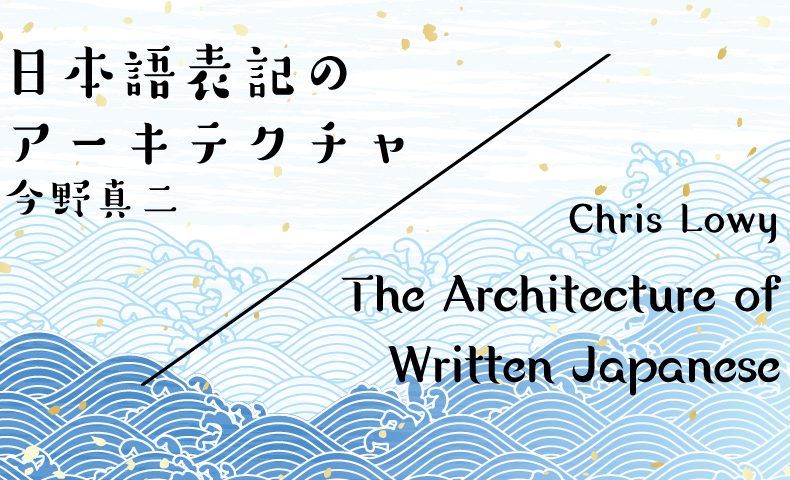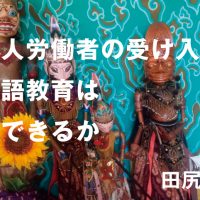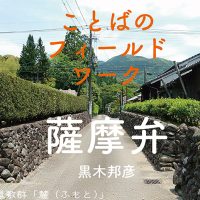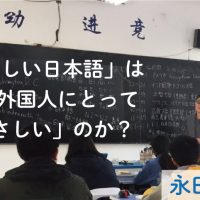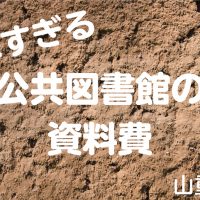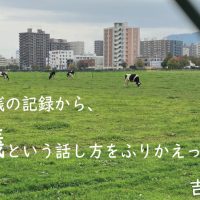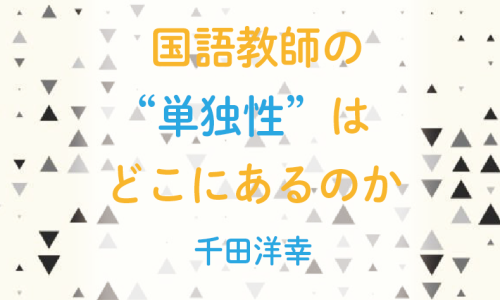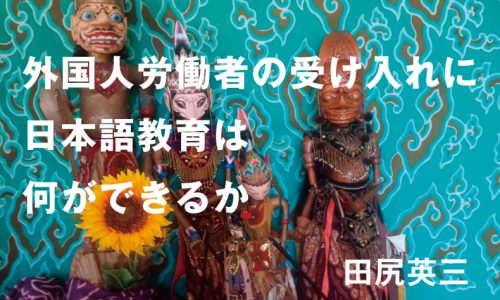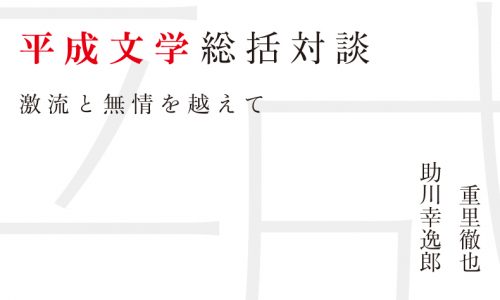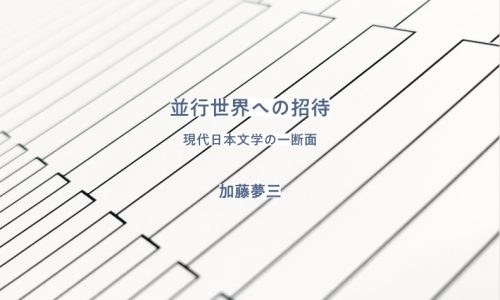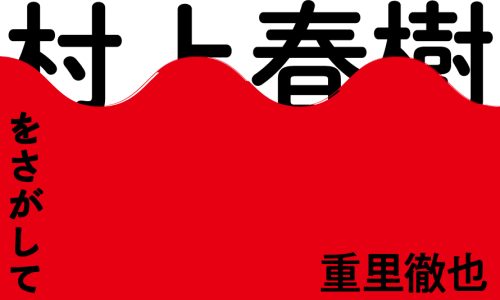今野真二
[漢字と仮名]
漢字から(漢字ではない文字である)仮名がうまれた、とみた場合、漢字と仮名と2種類の文字種が存在するようになったことになる。漢字がどうなれば仮名になるのか、すなわちどのような「条件」が揃うと漢字という文字が仮名という別の文字になるのかということについては、整理しておく必要がある(註1)。また、文字の形は、「何によって何に書くか」ということ、すなわち筆記具によって左右される。したがって、筆記具の変化によって、体系内において字形の調整が行なわれることはあり得ることと思っておく必要がある。現代日本語がそうであるように、「平仮名」と「片仮名」との(なんらかの)異なりを認めるのであれば、漢字と片仮名と平仮名という3種類の文字種が存在していることになる。
築島裕(1981)は「平安時代に入ってから、漢文と万葉仮名とを交ぜ用いたものが現れる。その系列はずっと後まで続いて行き、中世以降の漢字平仮名交り文の一つの源をなすと思われる」(96p)と述べ、その一方で「漢文の訓点記入の世界では、万葉仮名の字画の一部を省略して、省画仮名(略体仮名)が生じ、又、字画全体を草体化して、草仮名・平仮名を生んだが、それらは間もなく衰え、省画仮名が発達して片仮名が完成した」(同前)と述べ、「二つの世界」を設定している。そして「平安初期に創始された訓点の世界の中では、平仮名・片仮名未分化の状態であった」(275p)と述べる。「未分化の状態」は「訓点の世界」内部ということになるが、いずれにしても、そうした「状態」はあったといえよう。
築島裕(1981)の言説は、平仮名、片仮名の発生を実際のテキストの状況、すなわち「具体相」の観察に基づいてのものであるが、そうした「みかた」に対して(と表現しておくが)、漢字と仮名、あるいは漢字と平仮名、片仮名をどのようにみればよいか、という原理面すなわち「抽象相」からの問いが成り立つと考える。
[平仮名と片仮名]
彼女は、デスクの上に置いてある印度製の煙草の箱の、白檀の木の蓋をカタンカタンとはしたなく鳴らしながら、中から巻煙草を取つて、唇でスツパスツパ音を立てつゝ吸ひ始めた。
(谷崎潤一郎「金と銀」:大正7:1918年10月、春陽堂『金と銀』所収、31p)(下線は稿者が施した)
何の検証も経ず、すぐに一般化することはできないけれども、文字化のしかたも含めて、引用した文が、大正7(1918)年という「具体」、谷崎潤一郎という「具体」を少なくとも当該時期の日本語使用者と共有しているとみることにさほどの不都合はないと考える。
今ここでは、平仮名と片仮名、特に片仮名がどのような語を文字化しているか、ということに観察を絞ることにする。そうすると、引用文においては「デスク」「カタンカタン」「スッパスッパ」という3つの語が片仮名によって文字化されている。
「デスク」は改めていうまでもなく英語「desk」をあらわしているので、「外来語」を片仮名によって文字化した例にあたる。
小野正弘(2007)は、「カタンカタン」は「かたいものがぶつかったとき、連続して出る音」(31p中段)、「スッパスッパ」は「タバコを盛んに吸うさま。すぱすぱ」(209下段-210p上段)と説明している。これらは品詞でいえば、副詞にあたり、オノマトペと呼ばれる語群にあたる。
すなわち、引用文においては「漢字平仮名交じり文」において、外来語とオノマトペとが(平仮名ではなく)片仮名で文字化されていることになる。
作品ではなく、『金と銀』というテキスト(単行本)を一つの単位として、観察すると、「パトロン」(patron:11p)「アトリエ」(atelier:15p)「シガレツト」(cigarette:18p)「ソオフア」(sofa:32p)「ポケツト」(pocket:63p)「ドオア」(door:94p)といった外来語が片仮名によって文字化されている。またオノマトペも次のように片仮名で文字化されている。振仮名は省き、必要と思われる場合は漢字列の後ろに丸括弧に入れて示した。
(1)いつも青野に金を貸す時のやうな、反抗的なイライラした調子ではなく(60p)
(2)妙にトゲトゲしい眼つきでお互ひの顔の中を見た。(73p)
(3)いつの間にか狡猾な表情がハツキリと浮かんで居る。(74p)
(4)断乎として抗弁すれば、彼等はいかにヤキモキしたつてグウの音も出ないだらう。(83p)
(5)大川は腹の底にシツカリとした成算を抱いて、身も心も軽々として居た。(94p)
その一方で、平仮名で文字化し、傍点を施している例がみられる。
(6)日中の暑熱が想ひやられるやうなかつきりと晴れた炎天から(61p)
(7)臆面もなく美人の前へ出て、而もこてこてと厚化粧をして(70p)
(8)弾かれたやうに部屋の中でどしんと一つ飛び上がつた。(84p)
(9)髪をてかてか分けた男が、附け狙はれて居るのだらう。(142p)
(10)バケツか何かへ水を注ぎ込まれる音がちよろちよろと聞えて居た。(167p)
さらに平仮名で文字化され、傍点も施されていない例もみられる。(下線は稿者による)
(11)その様子を見ると、痺れて居た青野の頭はづきづきと痛み出して(58p)
(12)青野のアトリエの扉を、こつこつと叩く者があつた。(58p)
(13)こんな事をもぐもぐとしやべり出した青野の顔を(74p)
(14)建物全体が宝石で作つた巨大な蜂の巣のやうにぎらぎらと輝いて居た。(98p)
(15)眼瞼がぱたぱたと蛾が飛ぶやうに動いたかと思つた。(110p)
現代日本語においては、「漢字平仮名交じり」の表記体において、外来語を片仮名で文字化することはかなり徹底していると思われる。日本語の3つの語種「和語」「漢語」「外来語」のうちの「外来語」を卓立させようとしていることになる。これは英語の中に混じる非英語をイタリック体をもって示すことと通う。改めていうまでもないが、「漢字片仮名交じり」の表記体の場合、片仮名を使って卓立させることはできない。
いかなる語が外来語であるか、という判断が「揺れる」可能性はあるが、それでもその「揺れ」はそれほどではないことが推測できる。
「漢字平仮名交じり」の表記体において、オノマトペを片仮名で文字化することは、「外来語」ほど徹底していないと思われる。それは、いかなる語がオノマトペであるかという判断そのものが通常の言語活動では必ずしもなされていないためであろうし、卓立させる必要性が「外来語」ほどはないためでもあろう。(6)~(10)は文字種を変えることによるのではなく、傍点を附すことによって卓立をはかっている。しかしその一方で、「漢字平仮名交じり」の表記体内で、卓立をしていないオノマトペは少なくない。(6)~(10)の例が存在していることによって、「卓立」をどのように実現するかということについて、片仮名による文字化をする、傍点を施すという2つのやりかたがあったことがわかる。これは、「漢字平仮名交じり」の表記体内で、語を卓立したい、目立たせたい場合には、デフォルトとして使っている平仮名ではない文字、すなわち片仮名で文字化するというやりかたと、文字は変えずに、符号(傍点)によって卓立を示すというやりかたがあったということで、「卓立」は表記意識の側にあり、それを実現する具体的なシステムとして、文字種の変更、符号の使用があったとみたい。
『金と銀』には次のような例もみられる。
(17)暫くバツが悪さうにもぢもぢして居たが(101p)
(18)此れですつかりケチを附けた。(102p)
(19)あの時はあゝ云ふハメになつたので(213p)
(20)それとも堪忍して貰ひたければお足をお出し、お足をおくれつたらよゥ!(56p)
(21)けれども君ィ、察して呉れやァ(232p)
「バツ」「ケチ」「ハメ」は外来語でなく、オノマトペでもない。(20)の「よゥ」(21)の「君ィ」「呉れやァ」の「ゥ」「ィ」「ァ」は小書きでもあり、語形の発音をより細かく示すために添えられているといってよいだろう。こうしたものを「片仮名」と認めるかどうかということがまずあろうが、今ここでは「片仮名」とみて話を進めることにする。
このような「発音をより細かく示すために」片仮名を添えるというやりかたは、江戸期に出版されたテキストにもみられる。
大正7(1918)年に出版された『金と銀』における片仮名の使い方を整理するならば、①外来語、②オノマトペ、③語形の発音を示す、という三つがあり、その他に(17)~(21)のようなものがある。
『金と銀』は「漢字平仮名交じり」で印刷されている。つまり「漢字平仮名交じり」をデフォルトとしている。そうした表記体において、ここでは片仮名がそれにあたることになるが、デフォルトとして選択されていない文字種が使われる場合、どのように使われるか、という観察は、第7回のテーマとかかわる。
「音声言語」においては、身振り、表情、声の大きさ、高低、強弱といった「言語外要素」が一定の機能をもっていることがよく知られている。「文字言語」についても、そうしたものがあることは想像されるが、それを要素として数え上げることは案外と行なわれていないのではないか。
[表記体]
まず、「言語をどのように文字化」しているかを「表記体」の概念とする。日本語の歴史全体をカバーする「表記体」を文字を軸として設定するならば、「漢字専用」「仮名専用」「漢字仮名交じり」という三つの「表記体」を設定することができる。「漢字仮名交じり」は「漢字平仮名交じり」と「漢字片仮名交じり」とを区別するのがよいだろう。9世紀末頃に仮名がうまれるまでは、必然的に「漢字専用」であり、仮名発生後も、「漢文」形式で日本語を文字化するということが行なわれていたと考えるならば、それも「漢字専用」ということになる。「仮名専用」はその「専用」を厳密に考えるならば、この「表記体」を採るテキストはきわめて限定的ということになるが、ごく少数の漢字を使ったとしても広義の「仮名専用」「表記体」と認めるのであれば、多くはないが、一定数のテキストは存在することになる。しかし、結局は「漢字仮名交じり」が、「表記体」としてはデフォルトになったことを思うと、文字化に漢字を使うということを前提として、その前提のもとに、平仮名、片仮名をどう使うかということが日本語の文字化の中心課題であったといってもよいだろう。したがって、日本語の歴史の観察も、いかなる「表記体」が、どのような内実をもって実現していたかということを軸とした観察であってもよいことになる。また、文字の機能を軸として「表記体」を設定するならば、「表意専用」「表音専用」「表意・表音」という三つの「表記体」を設定することができる。
「表記体」についても、やはり「具体」と「抽象」とのバランスが重要であると考える。「表記体」は表記システムとのかかわりにおいて考えるのが筋であろうから、そうした意味合いにおいては「抽象」的な思惟が求められる。しかしまた、具体的なテキストの観察なく、「抽象的な思惟」を展開させることはできない。具体的なテキストは、通常はシステムのもっている標準相において実現するであろうが、時にシステムのもっている最大限の可能性を示唆することがある。そうした「示唆」をめざとく拾い上げることも、また重要であると考える(註2)。
註1 現在、東京国立博物館に蔵されている「秋萩帖」と呼ばれるテキストがある。「秋萩帖」は、国立文化財機構の4つの国立博物館 (東京国立博物館、京都国立博物館、 奈良国立博物館、九州国立博物館)と研究所(奈良文化財研究所)とが 所蔵する国宝・重要文化財の高精細画像を提供する「e國寳」というサイトで、紙背に記されている「淮南鴻烈兵略間詁」も含めて全体を確認することができる。この「秋萩帖」は漢字から仮名がうまれる過渡的な様相を示す「草仮名」で書かれているという「みかた」があった。その一方で、築島裕(1969)は「「さう」の仮名とは、具体的には秋萩帖・賀歌切などに見えるもの、又、元永本古今集や東大寺切などに普通の仮名と混用して用ゐられているものを指したのであらう。発達史的に見れば、万葉仮名から平仮名へ発達して行く過程の途中に見られるもの、即ち貞観九年(八六七)の有年申文などのものもそれに当るわけだが、物語などで主として意味してゐるのは、「かんな」即ち平仮名と共時的に存在し、しかおそれと対立した字体概念であつて、平安中期以降に、意図的に作られた字体を指すのであらう。この草仮名の字母は、確かに貞観頃のものと比べて、数が多く、異質的である」(280p)と述べており、仮名発生以降に「意図的に作られた字体」であろうという推測が提示されていた。今野真二編(2018)では、「秋萩帖」が仮名発生後に書かれていることを再確認しながら、「秋萩帖」について多角的、総合的に論じている。佐藤栄作(2010)は「ひらがなは、漢字の草書体をさらに簡略化した一種の「極草」ともいえるものである」と述べる。首肯できる「みかた」であると考えるが、そうであれば、漢字から平仮名がうまれるということは、「草書体漢字」から「極草書体漢字=平仮名」がうまれたということになる。漢字から平仮名へがうまれるプロセス中に、過渡的な存在として「草仮名」があったとみる場合は、この「草書体漢字」と「極草書体漢字=平仮名」の間に「草仮名」が位置することになる。そうした「みかた」が成り立たないことは今野真二編(2018)においても論じられているが、「草仮名」は名称としても不都合であったといえるのではないか。今野真二(2020)は、これまで定義されることなく使われてきた「字を崩す」というとらえかたを①画と画とを連続させ、②回転的・曲線的にする「草化」という文字変形プロセスとしてとらえて概念化し、それを「草化」と呼ぶことを提案した。「草化」という概念及び呼称を使うならば、「草書体漢字」を「草化」したものが、佐藤栄作(2010)いうところの「極草」としての平仮名ということになる。「秋萩帖」において観察される仮名は、「極草」となって文字体系としての安定をみた平仮名が、「意図的に」「草化」のプロセスを遡って、あえて「草書体漢字」と「極草=平仮名」の中間あたりに位置する形を作ってみせた、ということであろう。その「意図」あるいは試みがいわば「真に迫ったもの」であったために、後の時代の眼には「過渡的な存在」にみえた。そうであるとするならば、「秋萩帖」の書き手には、佐藤栄作(2010)いうところの「ひらがなの字体のエレメント」も「草書の字体(引用者補:草書体漢字)と字体エレメント」もみえていたことになる。
佐藤栄作(2013)は「ひらがなのかたちが、つい100年前まで、漢字の草書と連続していたということを話しましたが、まさに、それを草書の側から見るなら、楷書とは異なる草書の字体があり、ひらがなと草書とは、字体の要素を共有していた=両者は連続していた。そのように考えるなら、ひらがなの字体として設定した基本要素・基本点画を、草書の字体の基本要素・基本点画とできるのではないか」(130p)と述べている。平安時代につくられたと考えられている、いわゆる「五大万葉集」(桂本・藍紙本・元暦校本・金沢本・天治本)はいずれも、漢字によって文字化された歌の左傍に平仮名によって文字化された歌を並べる「平仮名別提方式」を採る。こうしたテキストの存在は、「草書体漢字」と「平仮名」とを対立的かつ連続的にとらえる「みかた」(枠組み)が確立していたことを推測させる。「枠組み」は「抽象」であるが、その抽象的な「枠組み」内で、具体的にテキストをつくるということにおいては、「草書体漢字」と「平仮名」が文字として、あるいは書法として対立的にとらえられることになる。書にたけた人は、「草書体漢字」を「平仮名」に少し寄せるとか、「平仮名」を「草書体漢字」に少し寄せるということはすでに自由自在にできるようになっていたのではないかと臆測する。「秋萩帖」とこれらのテキストと、どちらが「先」であるかということは今後探っていく必要があるが、両者には広い意味合いでかかわりがある、と推測する。
註2 佐藤栄作(2013)の「いけのくんへの手紙」はそうした好例といえるだろう。
参考文献
小野正弘編 2007 『日本語オノマトペ辞典』(小学館)
今野真二 2020 「草の字体」(『清泉女子大学人文科学研究所紀要』第41号)
今野真二編 2018 『秋萩帖の総合的研究』(勉誠出版)
佐藤栄作 2010 「草の字体へ」(『アクセント史資料研究会論集』Ⅳ、所収)
佐藤栄作 2013 『見えない文字見える文字』(三省堂)
築島裕 1969 『平安時代語新論』(東京大学出版会)
築島裕 1981 日本語の世界5『仮名』(中央公論社)
Chris Lowy
In Part 2 I listed eight characteristics of the Japanese writing system that come together to form an architecture of script. In Part 3 I start my exploration of each individual characteristic, beginning with the three character sets that comprise the foundation of written Japanese: Sinographs, hiragana, and katakana. I use the term character set to refer variously to Sinographs, hiragana, and katakana, each of which comprises a discrete collection of characters that are differentiated from each other and are capable of functioning as independent sets. In practice, few texts today are written exclusively in a single character set, though historically this was not the case and contemporary exceptions abound.[1] In fact, most texts today are written in a combination of all three.
Sinographs, variously called Chinese characters in English, kanji (漢字) in Japanese, and hanzi in Chinese, are thought to have entered Japan via the Korean Peninsula around the fifth century. I use the term Sinograph to highlight the importance of this character set in establishing what many scholars refer to today as the Sinographic Cosmopolis (漢字文化圏)[2] – the literary and cultural tradition of East Asia in which knowledge and communication was established and disseminated through the shared usage of literary Sinitic (漢文). So, while the parameters of the term Sinograph is hotly contested – and something I devote a later installment to – it is useful to understand Sinographs as one of three primary character sets comprising the modern Japanese writing system. Within the Japanese context, Sinographs are generally read in one of two ways: either in a manner based on its Chinese pronunciation (音読み) or as a semantic equivalent to an already existing Japanese term (訓読み).
Hiragana and katakana, which comprise sets two and three, are both syllabaries derived from Sinographs with each being a discrete character set. Both sets contain 47 base characters that can be augmented with voiced, semi-voiced, and germinate consonant markers, and they can also indicate sliding sounds and long vowels. The entire spectrum of the modern standard Japanese language can, in theory, be represented in both hiragana and katakana, and as such all utterances in Japanese can be represented in either or both.[3] Both character sets are sometimes referred to collectively as kana.[4] Today, both kana sets are standardized, and the Ministry of Education produces a list of Sinographs they deem sufficient for daily life. When thinking about the relationship between written language and literature, though, it is how these different character sets interact with each other that is of interest to the literary scholar.
(i) Sinographs, Hiragana, Katakana
Sinographs are the only characters used to write the Chinese language in mainland China, Taiwan, and elsewhere. In modern standard Japanese, Sinographs are conventionally used to write (a) nouns, (b) adjectives, (c) adverbs, and (d) verbs, though, in practice, orthographical variation is ubiquitous. The following examples taken from Project Itoh’s 2008 science fiction novel Harmony demonstrate how Sinographs are used in an unmarked contemporary text. The English is taken from Alexander O. Smith’s 2010 translation.
(a)そして女子高生のわたしはといえば、大人になるなんてまっぴらだった。(11)
For a high school girl like me, growing up was the last thing I wanted to do. (10)(b)端的に、わたしとミァハは変な子供ではあった。(12)
Yeah, me and Miach were the weird kids. (11)(c)この思いやりと共同体意識にあふれたセカイにあって、完全に孤立していたいといえば嘘になるけど、それでもわたしは日々感じていた。(12)
In a world of kind, thoughtful, group-consciousness types, we might not have been entirely on our own, but we sure felt like it. (11; emphasis in translation)(d)けれど、ミァハに、どうしてわたしとつきあうの、とはついに一度も訊いたことがない。(13)
Sometimes I wondered why [Miach] hung out with us at all, but I never asked. Not once. (11)
It is important to note that while (a) is written exclusively in Sinographs, (b), (c), and (d) necessitate the presence of hiragana to indicate linguistic function.[5] While this mixing of three character sets might seem unnecessary or redundant – and, indeed, there have historically been calls from both inside and outside of Japan to simplify the writing system – it suits the linguistic characteristics of the language surprisingly well.[6] For example, because Japanese is not a tonal language it does distinguish between discrete terms as easily as Chinese, Vietnamese, or Thai, and thus homophones abound in Japanese where they might otherwise be differentiated in other languages. For this reason, writing Japanese in hiragana or katakana alone would likely create more confusion than not.[7]
(ii) Hiragana and Katakana
If one relationship between Sinographs and kana within the context of modern Japanese today is largely determined by a need to establish intelligibility, the relationship between hiragana and katakana is a bit more complex. Hiragana, for example, is sometimes regarded as ancillary to Sinographs, the thread that holds the (written) language together. As one scholar puts it, hiragana is generally understood as a character set “used for particles, auxiliary verbs, and the inflectional affixes of nouns, adjectives, and verbs – in sum, the grammatical elements of sentences” (1996). Katakana, on the other hand, is often described as a character set used to write words of foreign origin, for emphasis, etc. As Konno notes in his contribution, however, an analysis of fiction reveals a far richer story. Using quotations from Tanizaki Jun’ichiro’s short story Kin to gin (Gold and Silver, 1918), he demonstrates the versatility both hiragana and katakana can play within the literary realm, and indeed within the same literary text. Though we should not regard Tanizaki’s use of written language here as representative of a random individual writing in Japanese in 1918, we can regard it as being unremarkable. Indeed, in Kin to gin the language itself is not the focus of the narrative.
For the rest of this installment I rely on Konno’s quotations and provide translations of his selections.[8]
彼女は、デスクの上に置いてある印度製の煙草の箱の、白檀の木の蓋をカタンカタンとはしたなく鳴らしながら、中から巻煙草を取って、唇でスッパスッパ音を立てつつ吸ひ始めた。(1918 31)
She took out a rolled cigarette and began smoking it, making puffing sounds with her lips all the while indecorously click-clacking the lid of an Indian-made sandalwood cigarette case sitting atop of the desk.
There are three words written in katakana: (i) デスク (desuku), (ii) カタンカタン (katan katan), and (iii) スッパスッパ (suppa suppa). (i) is the English word “desk” rendered into Japanese. Konno, citing Ono Masahiro (2007), defines (ii) as the sound made when hard objects continuously collide with one another while (iii) is the sound of richly puffing away on a cigarette. Thus, (i) is a word of foreign origin while (ii) and (iii) are onomatopoeia, the two primary functions of katakana in modern standard Japanese. Sentences (a) – (d) below are more examples of onomatopoeia being written in katakana.
(a)いつも青野に金を貸す時のやうな、反抗的なイライラした調子ではなく(60)
It wasn’t the usual defiantly pissed-off manner exhibited when lending money to Aono [.](b)妙にトゲトゲしい眼つきでお互ひの顔の中を見た。(73)
He looked between their faces with a strangely stinging stare.(c)いつの間にか狡猾な表情がハッキリと浮かんで居る。(74)
Before he knew it, a cunning expression had clearly surfaced.(d)大川は腹の底にシッカリとした成算を抱いて、身も心も軽々として居た。(94)
Firmly embracing hope, О̄kawa was at ease in both body and mind.
Konno identifies other words of foreign origin in Tanizaki’s piece: パトロン (patron 11), アトリエ (atelier 15), シガレット (cigarette 18), ソオファ (sofa 32), ポケット (pocket 63), and ドオア (94).
Interestingly, however, if katakana is used to write onomatopoeia, the inverse is not true: onomatopoeia need not be written in katakana! As sentences (e) – (k) demonstrate, many are written in hiragana. Furthermore, (e), (f), and (g) have markings attached to them, differentiating them from the surrounding text.
(e)もしも容貌の醜い女が、臆面もなく美人の前へ出て、而もこてこてと厚化粧をして(70)
What if an unsightly woman appears without reserve in front of a true beauty, and in thickly applied makeup no less, […](f)髪をてかてか分けた男が、付け狙はれて居るのだらう。(142)
The man whose part glistened with hair wax was no doubt being followed.(g)バケツか何かへ水を注ぎ込まれる音がちょろちょろと聞えて居た。(167)
I could hear the rippling sound of water being poured into a bucket or something.
Sentences (h) – (k) demonstrate that at times Tanizaki saw no need to either write onomatopoeia in katakana or attach markings atop them.
(h)その様子を見ると、痺れて居た青野の頭はづきづきと痛み出して(58)
Seeing that, the hitherto numb Aono felt a stinging sensation in his head […](i)青野のアトリエの扉を、こつこつと叩く者があった。(58)
Someone was banging on the door of Aono’s workshop.(j)建物全体が宝石で作った巨大な蜂の巣のやうにぎらぎらと輝いて居た。(98)
The entire building shone dazzlingly like a giant bee’s nest made of gems.(k)眼瞼がぱたぱたと蛾が飛ぶやうに動いたかと思った。(110)
[О̄kawa] thought he saw [Aono’s] eyelids move like a moth fluttering away.
With a few exceptions, it is today a universally accepted practice to write words of foreign origin in katakana. In this way, katakana functions like italics in English – it is a visual indicator to the reader that they ought to pay special attention to what they are about to read. On the other hand, the practice of writing onomatopoeia in katakana is less established. Konno posits that one reason might be the sometimes-ambiguous nature of onomatopoeia – what exactly counts as one and why – and another being a general lack of need to differentiate such words from the surrounding text in the way that foreign words warrant such treatment. Indeed, it may be these two final reasons that allow Tanizaki to attach emphasis markings to onomatopoeia written in hiragana while opting to not write them in katakana.
I conclude this installment with four other sentences Konno cites and the particular use of katakana found therein.
(l)暫くバツが悪さうにもぢもぢして居たが(101)
For a while he fidgeted about as if he were embarrassed […](m)此れですっかりケチを附けた。(102)
At this he expressed his wholehearted discontent.(n)あの時はあゝ云ふハメになったので(213)
Since at that time that’s what happened […](o)けれども君ィ、察して呉れやァ(232)
But you, just imaaagine!
In addition to the two functions of katakana described above – indicating foreign terms and onomatopoeia – we see in (l) – (n) katakana used to write nouns and, in the case of (o), indicating subtilities of pronunciation. Such usages of katakana can, Konno notes, also be found in Edo period (1600-1868) manuscripts. This ability for interchangeability is one key feature of written Japanese, and something we will take up in more depth later. The significance of these changes, I argue, can only be understood when read against narrative content.
Works Cited
- Itō Keikaku. Haamonii, Hayakawa shobo 2008.
- Lurie, David. Realms of Literacy: Early Japan and the History of Writing, Harvard University Asia Center 2011.
- Ono Masahiro. Nihongo Onomatopoeia jiten, Shogakukan 2007.
- Pollock, Sheldon. The Language of the Gods in the Worlds of Men: Sanskrit, Culture, and Power in Premodern India, University of California Press 2009.
- Project Itoh, trans. Alexander O. Smith. Harmony, Haikasoru 2010.
- Saito Mareshi, trans. Ross King and Christina Laffin. Kanbunmyaku: The Literary Sinitic Context and the Birth of Modern Japanese Language and Literature, Brill 2021.
- Smith, Janet Shibamoto. “Japanese Writing” in The World’s Writing Systems, Oxford University Press 1996.
- Tanikawa Shuntarō. Hadaka: Tanikawa Shuntarō no shishū, Chikuma shobo 1988.
- Tanizaki Jun’ichirō. “Kin to gin” in Kin to gin, Shunyodo 1918.
[1] Many texts written in literary Sinitic (漢文), for example, were written exclusively in Sinographs. Thus, the association between Sinographs and the legacy and influence of literary Sinitic is a strong one. However, as I stressed in Part 2, a particular character set does not necessarily correspond to a particular language. For example, the Kojiki, often regarded as the earliest extended piece of writing written in Japanese, was written exclusively in Sinographs. Nevertheless, through its use of Sinographs it indicated the Japanese pronunciations of proper nouns. Furthermore, and more dramatically, the Man’yōshū, the oldest extant collection of Japanese-language poetry, was written exclusively in Sinographs but in a phonetic manner that transcribed the sounds of vernacular Japanese largely removed from the semantic meaning of the individual Sinograph. This use of Sinographs is collectively referred to as Man’yōgana – kana in the Man’yō style – and is an early progenitor of the later hiragana and katakana character sets. Today, too, we may find some texts written in a single character set: the poet Tanikawa Shuntarō’s poetry collection Hadaka (1988), or “Naked,” for example, is written exclusively in hiragana.
[2] Zev Handel (2019) prefers the term “Sinographosphere” because his interests lie in the localization processes of Sinographs in different linguistic environments, especially those from typologically different languages (e.g., Chinese and Japanese, Vietnamese, and Korean). The term preferred by Saito Mareshi (2021) and others, of course, is inspired by Sheldon Pollock’s formulation of a “Sanskrit Cosmopolis” (2009) and is thus more focused on the cultural impact of the language.
[3] This clean and tidy view of kana is misleading: as we will see in the next installment, authors writing in non-standard Japanese are forced to be creative when writing in any manner that deviates from the modern standard language.
[4] For an overview of hiragana and katakana within the larger context of the history of writing in Japan, see “Japan and the History of Writing” in David Lurie’s important Realms of Literacy: Early Japan and the History of Writing (2011).
[5] Strictly speaking, the Sinographs in (b) and (c) – 変 and 完全 – can stand alone as nouns. When they are used as adjectives, however, they have hiragana attached to them. In the case of (d), the hiragana that follow the kanji 訊 are called okurigana (送り仮名), a general term for kana attached to a Sinograph that disambiguates its reading.
[6] For a book-length discussion on the ideology behind various movements to abandon Sinographs in Japan, see Yasuda Toshiaki’s Kanji haishi no shisо̄shi (Heibonsha 2016).
[7] While some premodern texts were written largely in either hiragana or katakana, the story is more complicated than it is today: before kana spelling was standardized in the modern era, there were various ways to write a Sinograph’s reading in kana that might distinguish between terms. For example, while 鵠, 鉱, 公, 行 and 劫 would each be written こう kо̄ today, in premodern texts they might be written こふ, くわう, こう, かう, and かふ, respectively.
[8] Konno leaves the quotations in the historical orthography. Whereas I have left the prewar spellings, I have slightly altered the text to indicate long vowels and geminate consonants more clearly.

